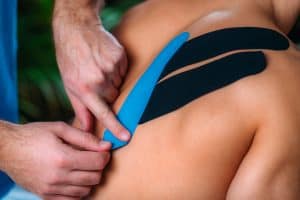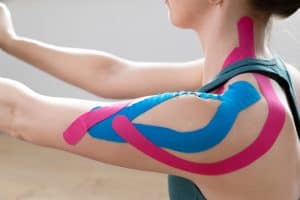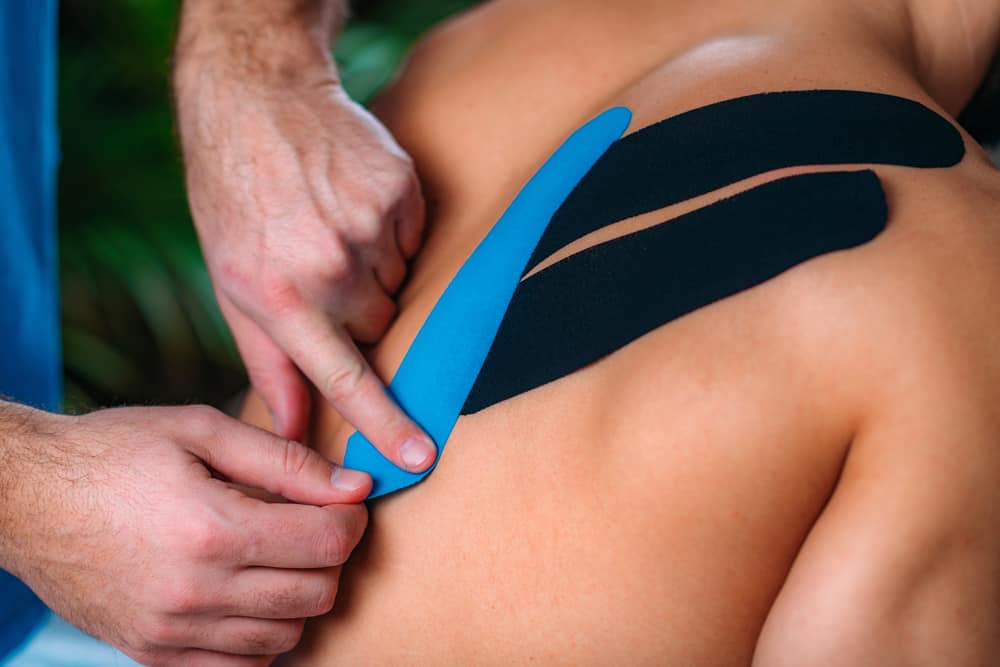If you’re a big fan of sports or follow the Olympic Games, you’ve likely noticed athletes with bright, colorful adhesives on certain parts of their bodies—whether it be on the stomach, the arms, the leg, or even the face.
They’re hard to miss, especially with so many professionals using them!
These adhesives are called kinesiology tape. Because of all the advantages they provide, they’re a runner’s favorite therapeutic tape. They not only improve athletic performance but also treat injuries and reduce pain.
Rock Tape and KT Tape are two of the most popular brands of kinesiology tape. But if you had to choose just one, what brand should you go for?
In this Rock Tape vs KT Tape comparison guide, we discuss the major differences and similarities of these two tapes, as well as their many functions.
Let’s dive right in!

What Is Kinesiology Tape and How Does It Differ From Ordinary Athletic Tape?
Kinesiology tape, otherwise known as kinesiology therapeutic tape or simply Kinesio tape, is an elastic adhesive tape primarily used for athletic injuries and physical disorders. It’s usually made of fine, breathable material, such as cotton or a soft cotton blend.
This therapeutic tape is carefully designed to provide just enough pressure to support and promote strength to certain groups of muscles and tissues.
When strategically applied to the body, it not only reduces swelling but also stabilizes the injured area and lessens the pain overall.
Compared to ordinary medical or athletic tape, kinesiology tape is extremely stretchy. In fact, some brands can stretch up to 200% of their original length!
Athletic tape is the complete opposite; it isn’t stretchy at all and is usually only used to tightly wrap an area.
Kinesiology tape comes in multiple color variations, like beige, blue, pink, and green. Athletic tape only ever comes in white.
Furthermore, kinesiology tape is water-resistant whereas athletic tape isn’t. This is why athletic tape is usually only ever applied short-term—to prevent skin irritations.
Kinesiology tape is strong enough to stay on the skin for up to five days even when it regularly comes in contact with water, such as when you take a shower or sweat after a long run.
Kinesiology tape and athletic tape have two different purposes, so it’s unfair to say one is better than the other.
The former reduces swelling and enhances the movement of weak muscles; the latter immobilizes and restricts the movement of an injured joint to protect it from further damage.
Most importantly, athletic tape can decrease circulation whereas kinesiology tape can improve circulation.
Does Kinesiology Tape Actually Work?
The short answer is yes, kinesiology tape works—it wouldn’t be as globally used if it didn’t.
However, we do need a bit more research to answer this question with complete confidence.
The research that exists today is inconsistent at best. Some swear by its effectiveness, while others indicate no difference, going as far as calling it a placebo product.
To summarize sports journalist Tim Locke, “There hasn’t been any conclusive medical or scientific evidence to confirm the tape’s effectiveness.”
With that said, kinesiology tape does have several theoretical benefits.
Since it doesn’t hinder movement like athletic or medical tape, it can likely enhance movement and endurance in performing athletes. In fact, some studies show that kinesiology tape improves the performance of fatigued muscles due to the support it provides.
Additionally, kinesiology taping can be used to re-educate or retrain muscles that have lost function, such as correcting neck and head posture. It’s also believed to help stroke patients improve the way they walk.
But again, this may not be due to the tape itself; it may just be associated with the strange and obvious sensation of tape on the skin, making patients more aware of how they’re moving or standing.
Overall, the effectiveness of kinesiology tape is still debated to this day.
The International Journal of Sports Physical Therapy (IJSPT) concludes that kinesiology tape is most effective in conjunction with other treatment methods, such as icing or heat therapy.

How Does Kinesiology Tape Work, Exactly?
Kinesiology tape allows blood and other bodily fluids to move freely around and through the injured muscle. It also stabilizes an injured area by lightly applying pressure to the tissues it’s wrapped around without restricting movement.
When properly applied, the kinesiology tape increases the flow and circulation of lymphatic fluids. It “lifts” the skin and increases the interstitial space below it, thus reducing the swelling.
The space increase is believed to reduce pressure on the body’s pain detectors (nociceptors). It’s also believed to stimulate the sensory receptors to further improve self-movement, body position, and joint proprioception.
This is why physical therapists often place kinesiology tape on the body’s trigger points—to lift the skin over the tense, knotted muscles.
According to board-certified conditioning specialist Dr. Megann Schooley, the lift that kinesiology taping creates unloads and decompresses underlying tissues, which then changes the signals going to the brain.
And since kinesiology taping alters the flow of lymphatic fluid, it can also possibly help heal bruises faster.
Although yet to be confirmed by medical professionals, a few studies and reports state that when they’ve removed the tape from a bruised area, the area under the tape is different from the same bruised but untaped area.
Rock Tape vs KT Tape: Notable Features, Similarities, and Differences
Rock Tape and KT Tape are two of the more trustworthy kinesiology brands in the market today. But how do they stack up when compared toe-to-toe? Let’s find out:
Material
Rock Tape and KT Tape are made of high-quality materials of varying compositions.
Rock Tape is composed of 97% hemp and 3% nylon, whereas KT is made of 100% cotton.
Hemp is much stronger than cotton, so it’s no surprise that Rock Tape comes on top in the durability department.
KT Tape doesn’t falter much behind, though, and since it’s a lot softer than Rock Tape, it’s often the first choice of athletes who wear the tape for days at a time.
Rock Tape isn’t quite as comfortable to wear but isn’t itchy or distracting as other kinesiology tape brands.
Stretch
Kinesiology tape is known for its impressive stretch. In fact, it’s one of the more notable features of this product.
When stretched greater than its normal length, the tape snaps back and creates a pulling force on the skin. This grants users a greater range of motion, thus allowing them to leave the tape on the injured area for long periods before reapplication.
In general, kinesiology tapes come with around 80 to 140% stretch.
Rock and KT raised the bar by giving their respective products a brow-raising stretch of 180%—almost double the tape’s original size.
This stretch ensures that you can perform all movements without restriction or discomfort.
The elastic property of both products effectively mimics the skin, connective tissues, and muscle. It also creates an almost invisible, non-painful stimulus, making it harder for the body to feel pain in the selected area.
Adhesive
Rock Tape provides support for three to five days per application whereas KT stays on the skin for one to three days. They’re both water-resistant, so they can be used while running, showering, and even swimming.
KT Tape’s patented Secondskin Adhesive feels a lot less sticky than Rock Tape, so you can sleep in it without feeling any kind of discomfort.
On the other hand, Rock Tape’s strong adhesive is quite noticeable upon initial use and may take a couple of hours—sometimes days—to get used to.
Ease of Use
Unlike KT Tape, Rock Tape doesn’t come in pre-cut strips—but this was a purposeful decision by the company.
“One size doesn’t fit all,” the company claims, “There’s a big difference between a 120-pound ballerina and a seven-foot-tall rugby player. That’s why our products aren’t pre-cut like our competitors.”
That certainly makes sense—after all, people have varying body shapes and injuries. If the tape was already pre-cut, you’ll be forced to use the entirety of the tape regardless of the size of the injury.
On the other hand, this also makes the application a bit more inconvenient. You can’t cut Rock Tape with your bare hands; you have to use a pair of scissors (or your teeth.)
KT Tape doesn’t have this issue.
Like Rock Tape, KT Tape understands that one size doesn’t fit all so the company offers an uncut version of its product. However, KT Tape also comes in pre-cut strips with circular corners so you don’t have to round and cut the tape every time you want to use it.
Each roll contains 20 10-inch “I” strips, all two inches wide. The company also offers other precut lengths. The KT Pro Extreme Precut Tape, for example, is seven inches wide and 10 inches long. So in terms of ease of use, KT Tape comes on top.
Hypoallergenic Properties
Both Rock Tape and KT Tape are latex-free and hypoallergenic. KT Tape also caters to individuals with extra sensitive skin with the KT Gentle Tape, which is easier to remove from the skin.
What Can Rock Tape and KT Tape Be Used For?
Rock Tape and KT Tape can be used for:
Treating Injuries
As two of the most well-known kinesiology tape brands in the US, it’s often used as a large part of an overall treatment plan for people who suffer from minor to severe injuries, such as:
- Acute low back pain
- Patellofemoral pain syndrome
- Osteoarthritis
- Tendinopathy
- Plantar fasciitis
- Shoulder impingement
- Bruises
- Shin splints
- Achilles tendon pain
- General muscle pain
Each of these injuries have a special way of treatment with kinesiology tape.
For plantar fasciitis, for instance, you have to tape the strip down the bottom of your foot, then cross it with another strip on the arch area of the foot.
For Achilles tendon pain, you have to tape the strip from the mid-calf down the bottom of the foot, then cross it with another strip on the back of the heel or ankle.
As for general soreness, you have to use two strips to border up the area.
It’s important to note that Rock Tape and KT Tape—or any other kinesiology tape for that matter—shouldn’t be used on open wounds, as using them over a wound can cause infection or skin damage.
It also shouldn’t be used if you’re suffering from deep vein thrombosis, lymph node removal, and active cancer. Kinesiology tape increases blood flow, which can be dangerous in these conditions.

Reducing Pain
Rock Tape and KT Tape apply just the right amount of pressure to alleviate and disrupt pain.
The science behind it is simple: when pressure is applied, it overwhelms the pain receptors with “pressure” signals that aren’t painful.
This phenomenon is called the Gate Control Theory of Pain. The sensation of pressure is transmitted faster than the sensation of pain, forcing the brain to essentially “shut the gate” to prevent both sensations from overwhelming each other.
Supporting Weak Muscles
Rock Tape and KT Tape can be used to add extra support to joints and muscles that need it.
This is extremely helpful for individuals with IT band friction syndrome, patellofemoral stress syndrome, and Achilles tendonitis.
Both tapes stabilize the injured area by applying pressure to the tissues they’re wrapped around and strongly adhering to the skin.
Reducing Scarring
Although they aren’t advertised as such, some evidence suggests that kinesiology tape in itself can improve the appearance of scars long-term, especially after an injury or surgery.
Of course, this kind of scar treatment should always be discussed with your physician first.
Enhancing Performance
You’ve likely seen professional athletes—like Katrin Holtwick, David Beckham, and Leryn Franco—wearing bright kinesiology tape during competition. If you’ve ever wondered why, it’s because kinesiology tape is believed to enhance athletic performance.
At the time of writing, KT Tape is Team USA’s “official kinesiology tape licensee.” According to the official website, KT Tape “facilitates stronger firing of muscles and tendons,” which helps athletes achieve peak performance and protect them against injury.
Runners, in particular, place the tape along the glutes to remind it to keep working.
Improving Posture
As discussed earlier, kinesiology tape is believed to improve and re-educate posture. It gently supports proper posture without forcing the body into it.
Furthermore, it trains the body to become efficient and independent—a far cry from other assistive devices that lead to dependence on support and stability.
Swelling Management
By decreasing pressure between underlying tissues and the skin, kinesiology tapes like Rock Tape and KT Tape can reduce swelling from a surgery or injury. The gentle pressure provides a pathway for excess fluid to flow through.
For this reason, kinesiology tape can be used in superficial contusions and lymphedema management.

How to Use Rock and KT Kinesiology Tape
The taping process of kinesiology tape ultimately depends on the type of injury or the effect you want it to have on your body. As such, it’s always best to consult a professional for advice when using a kinesiology tape of any brand.
Luckily, both KT Tape and Rock Tape provide detailed guides according to the body part you wish to tape. This includes how to tape your knees, calf, shin splints, hamstrings, abdominals, groin, and so much more.
KT Tape was generous enough to also provide detailed taping instructions and videos for issues such as Achilles Tendonitis, Peroneal Tendonitis, and Plantar Fasciitis.
Here are some instructions on using KT Tape and Rock Tape in certain areas of the body:
Neck and Shoulder
- Sitting down, bring your chest gently towards your chest.
- Tear a strip of tape in the center and peel the paper back.
- Place the tape just below your hairline, with 50% stretch, on either side of your spine. Smooth it down along the side of the discomfort.
- Cut another strip of tape and place it on the other side of the spine.
- Cut a final strip of tape, making sure it’s about half the length of the first two strips. Apply the third strip above the other two strips horizontally, directly above the site of the pain, at 80% stretch.
- Smooth all three strips down with your hand to make sure the strips have firmly adhered to your skin.
Lower Back
- While standing, flex forward at the waist so your lower back is slightly stretched.
- Without touching the adhesive, hold the ends of the tape and stick it horizontally below the site of the pain with a moderate stretch of about 30%.
- Repeat with a second strip parallel to the first, but this time directly on the site of pain.
- Smooth the tape down for improved adhesion.
Ribs
- Tear a strip of tape in the center and peel the paper back.
- Lean to one side to slightly stretch your rib cage.
- Apply one strip of tape with moderate stretch on the site of the pain. Place it horizontally.
- Cut another strip of tape and place it vertically above the first tape, directly on the site of pain. Make sure you don’t stretch the ends as you lay the tape down.
- Repeat with a third strip and place it behind the site of pain, just beside the second tape.
- Rub the application for improved adhesion.
Elbow
- Tear a strip of tape in the center and peel the paper slightly back in the middle.
- While sitting, bend your elbow so your palm is facing your shoulder.
- Place the first tape with zero stretch over your forearm approximately four inches below your elbow.
- As you direct the strip up to your elbow, apply a light stretch and place it over the back of your upper arm.
- Cut another strip of tape. With your arm bent towards your body, place the second strip towards the outer portion of your elbow and onto the back of your upper arm.
Heel
- Cut off one full strip of tape (about 4 to 5 inches) and place it horizontally under the heel with about 80% stretch. Smooth the tape down and make sure the heel is fully covered.
- Cut off another strip of tape and intersect it vertically with the first strip behind the heel. Use the same amount of stretch.
- Apply a final strip of tape on the sole of your foot with only 50% stretch. Then, smooth it under your heel and along your Achilles tendon with no stretch.
- Give the whole thing a final rub to let the adhesive really stick on your skin.
Final Thoughts On Rock Tape vs KT Tape
There you have it, our complete comparison guide of Rock Tape vs KT Tape! You can’t go wrong with either brand; they’re both among the most high-quality kinesiology tapes on the market today.
Overall, KT Tape has scored higher in almost every category we tested it on. It’s much more comfortable than Rock Tape because it’s made of 100% cotton instead of hemp and nylon.
Plus, it’s extremely easy to use with its pre-cut strips and circular corners, saving us a lot of preparation time during testing. With KT Tape, it’s quite literally just tear and apply.
KT Tape equally matches Rock Tape in terms of stretch and hypoallergenic properties, and although it doesn’t adhere as strongly as Rock Tape, the difference isn’t much of a concern if you’re planning to use it only for two to three days.
If adhesion matters more to you than anything else, though, absolutely go with Rock Tape.

